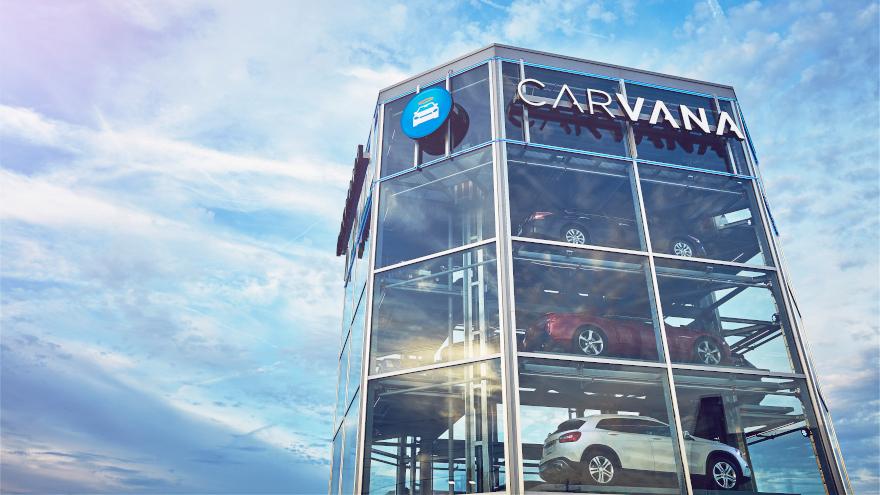Details of Carvana’s updated operating plan

Carvana’s Nashville, Tenn., vending machine. Photo courtesy of Carvana/BusinessWire.
Carvana said it would share an updated operating plan after it announced the cutting of approximately 2,500 workers last Tuesday.
Well, that plan has been released, and it includes not only more details about the future of ADESA operations, Carvana also pinpointed its top two priorities for managing its business.
Those priorities include:
1. Rapidly reduce SG&A expense per retail unit sold while taking care to minimize constraints on growth or impacts to customer experience. For reasons we discuss later in these slides,
2. Generate positive free cash flow through a combination of retail units, GPU, SG&A expense efficiencies and management of capital expenditures to achieve self-funding without requiring additional equity or debt capital.
“We currently view SG&A expense per retail unit sold as our highest priority and intend to lower it in both the near term and midterm while continuing to grow on the path toward our long-term goals,” Carvana said in a presentation on its investor relations website.
Carvana explained that in the past, the company has typically executed a seasonal investment cycle in which it would “significantly” ramp up infrastructure and operations in the second half of each year to prepare for seasonal demand late in the following first quarter.
“In 2H18, we underinvested in our operational infrastructure, leading to pinch points that limited sales volume when seasonal demand increased in 1Q19,” Carvana said in the presentation.
“In 2H19, we ramped our investment in preparation for seasonal growth in 1Q20; however, 1Q20 was significantly impacted by COVID-19, leading to elevated levels of SG&A per unit in Q1 followed by leverage in Q2 and Q3,” the company continued.
“In 2H20, we maintained a lower level of seasonal investment due to uncertainties surrounding the COVID-19. This led to renewed constraints in 1H21 when demand significantly rebounded,” Carvana added.
But due to what Carvana called “a variety of external and internal factors,” the retailer said it did not see the planned seasonal sales increase in the first quarter of this year, leading to an elevated per unit SG&A.
Along with reducing its workforce, Carvana said it has “numerous levers to better align expenses with sales volume.” The company articulated them in the presentation.
“In addition, we expect normal attrition, scheduling optimization, and in-sourcing in operational groups to lead to further alignment between staffing and volume,” Carvana said.
“We expect advertising spend to decline in absolute terms in Q2 on higher sales volumes moving beyond our Super Bowl and tax season advertising in Q1,” the company continued.
“We also plan to reduce dollar spend in other areas where we see opportunities for efficiencies or savings,” Carvana went on to say.
With this plan in place, Carvana said it expects profitable growth, SG&A leverage, and a return to more than $4,000 total GPU to lead to significant positive EBITDA for the full year 2023.
Plans for ADESA
Later in its presentation, Carvana reiterated its top five priorities for leveraging ADESA, which officially became part of the company on the same day as the workforce reduction was announced. Those priorities include:
1. Business as usual at ADESA
2. Direct-to-destination wholesale cars
3. Retail market and logistics hubs
4. Utilize existing reconditioning capacity
5. Faster retail delivery times
“Over time, we also expect to build out additional reconditioning capacity at ADESA locations to move from 200,000 to 2 million annual units of capacity at full utilization,” Carvana said.
Carvana said the ADESA physical auction business will continue to be run by the same leadership team who managed the business at KAR Global, “helping to ensure a seamless transition.”
Carvana then said, “Similarly, we expect to utilize ADESA’s network to expand our market and logistics hub footprint, reducing expected vehicle moves and miles traveled.”
The company added, “We estimate that ADESA’s existing sites have the capacity to inspect and recondition ~200k retail units per year with limited incremental capital investment. We plan to scale into this capacity and beyond over time.”
Carvana wrapped its presentation segment about ADESA with another acknowledgement.
“One question we have received from investors is why did we purchase of ADESA now, when used vehicle market volume is down, we have significant excess reconditioning capacity in our existing IRCs, and sentiment in financial markets is incredibly low?”
Carvana replied with a three-part answer.
“First, we have a tremendous level of conviction in both the long-term value of ADESA, its unique strategic assets, and its team, as well as our ability to generate positive free cash flow to service the financing associated with the purchase price and prefunded capital expenditures,” Carvana said.
“Second, our purchase of ADESA is not just about long-term reconditioning capacity. ADESA also generates meaningful benefits in the near-term by facilitating incremental unit economics and simplifying aspects of our last-mile delivery and logistics network,” the company continued.
“Third, we believe the near-term net carrying costs of the ADESA transaction are much smaller than the headline interest rate suggests, leading to an expected net positive impact to financial flexibility,” Carvana went on to say.
Carvana’s entire updated operating plan can be found via this website.

 View The Latest Edition
View The Latest Edition

